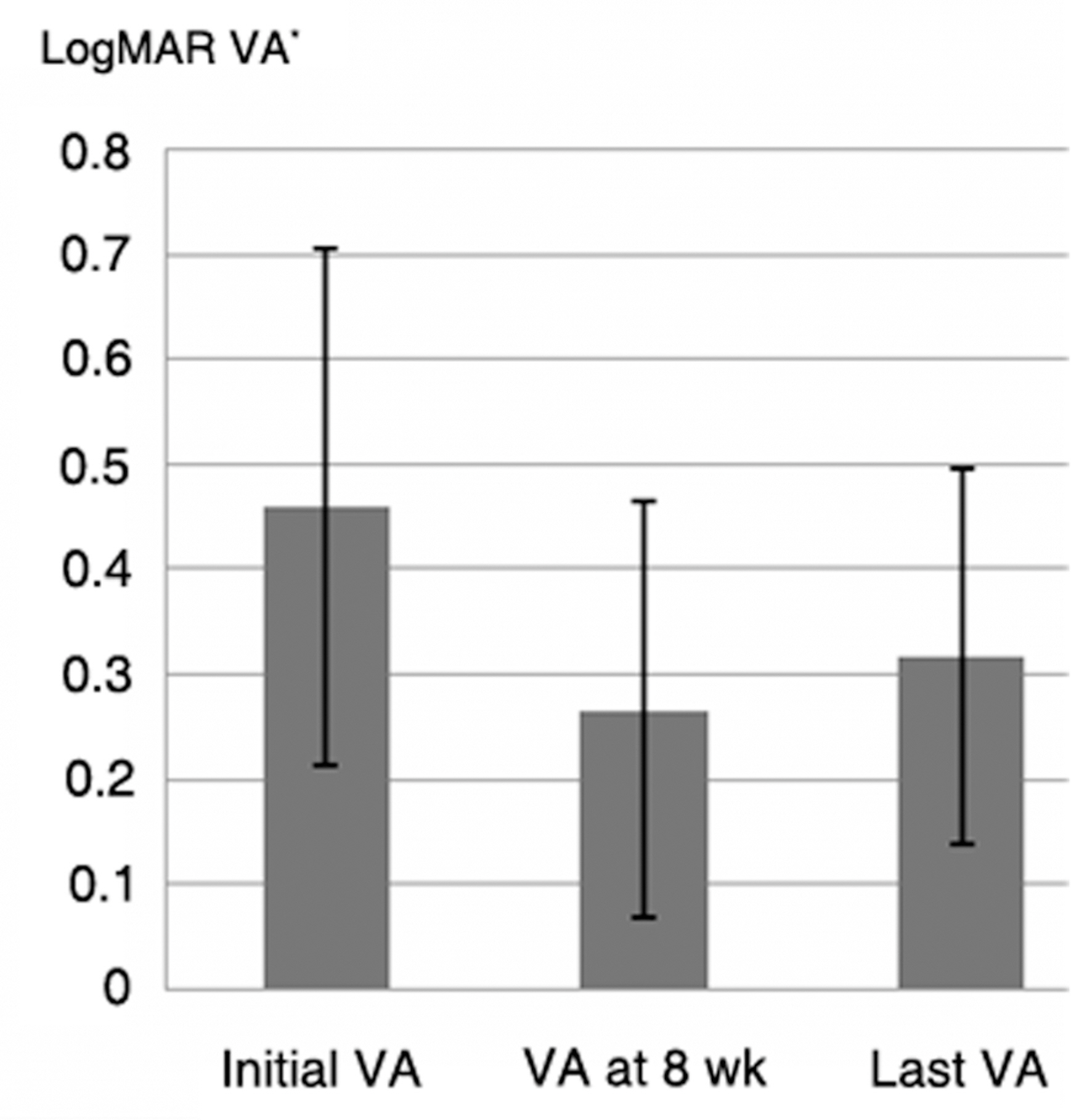J Korean Ophthalmol Soc.
2009 Nov;50(11):1692-1697.
Long-Term Study of Levodopa/Carbidopa for Refractory Childhood Amblyopia
- Affiliations
-
- 1Department of Ophthalmology, Korea University College of Medicine, Ansan, Korea. ansaneye@hanmail.net
- 2Department of Neurology, Korea University College of Medicine, Ansan, Korea.
Abstract
- PURPOSE
To evaluate the long-term (12 to 30 months) effect of L-dopa with part-time occlusion in patients in which occlusion therapy failed. METHODS: Seventeen eyes of 12 amblyopic children who failed with part-time occlusion (4 to 8 hours/day) treatment for a minimum period of 6 months were studied. The follow-up period was 12 to 30 months. The average best corrected visual acuity (BCVA) before treatment was 0.28+/-0.20 (0.05-0.5). After full informed consent was obtained from their parents, the children received levodopa (2 to 4 mg/kg) for 8 weeks combined with part-time occlusion and spectacles.
RESULTS
The average age of the subjects was 7.0+/-2.7 years and the mean follow-up period was 23.7+/-7.7 (12 to 30) months. After the administration of levodopa for 8 weeks, 9 eyes (53%) showed improvement in BCVA, and only 4 eyes showing a mean regression of 0.20+/-0.11 logMAR visual acuities. The BCVA reached the maximum value after a mean of 8.47 months. After 8 weeks from baseline, 13 eyes (76%) reached the maximum BCVA. After 12 to 30 months of follow-up, 12 out of 17 eyes (70.6%) showed a BCVA improvement of 0.14+/-0.19 logMAR.
CONCLUSIONS
After the long-term (12 to 30 months) follow-up, L-dopa with part-time occlusion in patients in which occlusion therapy failed showed improved visual acuities in 76% of the cases.
MeSH Terms
Figure
Reference
-
References
1. von Noorden GK, Campos EC. Binocular Vision and Ocular Mo-tility. 6th ed.St Louis: Mosby;2002. p. 246.2. Beardsell R, Clarke S, Hill M. Outcome of occlusion treatment for amblyopia. J Pediatric Ophthalmol Strabismus. 1999; 36:19–24.
Article3. Campos EC, Fresina M. Medical treatment of amblyopia: present state and perspectives. Strabismus. 2006; 14:71–3.
Article4. Kim SH, Shin HH, Koh SB, Cho YA. The Effect of L-dopa in Amblyopic Children for Whom Occlusion Therapy Failed. J Korean Ophthalmol Soc. 2006; 47:443–8.5. Fredrick JM, Rayborn ME, Laties AM, et al. Dopaminergic neurons in human retina. J Comp Neurol. 1982; 210–65.6. Daw NW, Rader RK, Robertson TW, Ariel M. Effect of 6-hydroxy-dopamine on visual deprivation in the kitten striate cortex. J Neurosci. 1983; 3:907–14.7. Kasamatsu T, Pettigrew JD. Depletion of brain catecholamines: fai-lure of ocular dominance shift after monocular occlusion in kittens. Science. 1976; 8194:206–9.
Article8. Pettigrew JD, Kasamatsu T. Local perfusion of noradrenaline main-tains visual cortical plasticity. Nature. 1979; 271:761–3.
Article9. Kasamatsu T. Enhancement of neuronal plasticity by activating the norepinephrine system in the brain: a remedy for amblyopia. Hum Neurobiol. 1982; 1:49–54.10. Imamura K, Kasamatsu T. Interaction of noradrenergic and cholinergic systems in regulation of ocular dominance plasticity. Neurosci Res. 1989; 6:519–36.
Article11. Kasamatsu T, Heggelund P. Single el responses in cat visual cortex to visual stimulation during iontophoresis of noradrenaline. Exp Brain Res. 1982; 45:317–27.12. Gottlob I, Stangler-Zuschrott E. Effect of levodopa on contrast sensitivity and scotomas in human amblyopia. Invest Ophthalmol Vis Sci. 1990; 31:776–80.13. Leguire LE, Rogers GL, Bremer DL, et al. Levodopa and childhood amblyopia. J Pediatr Ophthalmol Strabismus. 1992; 29:290–8.
Article14. Leguire LE, Rogers GL, Bremer DL, et al. Levodopa/carbidopa for childhood amblyopia. Invest Ophthalmol Vis Sci. 1993; 34:3090–5.15. Leguire LE, Walson PD, Rogers GL, et al. Longitudinal study of levodopa/carbidopa for childhood amblyopia. J Pediatr Opbthalmol Strabismus. 1993; 30:354–60.
Article16. Gottlob I, Charlier J, Reinecke RD. Visual acuities and scotomas after one week levodopa administration in human amblyopia. Invest Ophthalmol Vis Sci. 1992; 33:2722–8.17. Leguire LE, Walson PD, Rogers GL, et al. Levodopa/carbidopa treatment for amblyopia in older children. J Pediatr Ophthalmol Strabismus. 1995; 32:143–51.
Article18. Gottlob I, Wizov SS, Reinecke RD. Visual acuities and scotomas after 3 weeks' levodopa administration in adult amblyopia. Graefes Arch Clin Exp Ophthalmol. 1995; 233:407–13.
Article19. Leguire LE, Rogers GL, Walson PD, et al. Occlusion and levodopa-carbidopa treatment for childhood amblyopia. J AAPOS. 1998; 2:257–64.
Article20. Leguire LE, Komaromy KL, Nairus TM, Rogers GL. Long-term follow-up of L-dopa treatment in children with amblyopia. J Pediatr Ophthalmol Strabismus. 2002; 39:326–30.
Article21. Ferris FL III, Kassoff A, Bresnick GH, Bailey I. New visual acuity charts for clinical research. Am J Ophthalmol. 1982; 94:91–6.22. Lee JH, Choi DG. Effect of levodopa on visual function in amblyopia. J Korean Ophthalmol Soc. 1996; 37:1354–9.23. Mohan K, Dhankar V, Sharma A. Visual acuities after levodopa administration in amblyopia. J Pediatr Ophthalmol Strabismus. 2001; 38:62–7.
Article
- Full Text Links
- Actions
-
Cited
- CITED
-
- Close
- Share
- Similar articles
-
- Liquid Levodopa/Carbidopa: Old Solution, Forgotten Complication
- Continuous 24-h Levodopa-Carbidopa Intestinal Gel Infusion After a Levodopa Holiday Suppressed Refractory Dyskinesia Despite Increasing Levodopa Dose
- Levodopa Pharmacokinetics in Switching From Levodopa/Carbidopa Intestinal Gel to Continuous Subcutaneous Foslevodopa/Foscarbidopa Infusion in a Patient With Parkinson’s Disease: A Case Report
- The Effect of Levodopa on Akinetic Mutism in Bilateral Anterior Cerebral Artery Infarction: A case report
- The Therapeutic Effect of Drug in Parkinson's Disease



